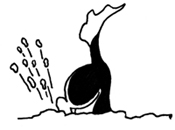The Right Approach Makes All the Difference
 Each question or challenge helps to shape the best method of discovery. We consider:
Each question or challenge helps to shape the best method of discovery. We consider:
- what is being asked
- the types of knowledge that already exist about a market or client
- the goals/intended outcomes of the research, and
- budgetary/time considerations.
No matter what the question/challenge, just a few of the tools we have at our disposal to craft the ideal research approach include:
Qualitative Tools
Focus on engaging market members deeply, often in the environments in which they already work, live, or travel.
These tools provide rich insights that are usually themed into lists of core psychological and motivational drivers of the market.
Ethnographic Immersion

Researchers enter the culture with the skill of a chameleon, blending into their surroundings while keeping a keen eye and ear out for the rules, habits, patterns, and tendencies which make the culture tick.
Gives light to insights which are rarely revealed in interviews or other direct communication environments.
Shop-Alongs/Observational Shadowing
Take place in and around the places where decisions and communication naturally occur.
For example, much of our work in healthcare involves observational shadowing in waiting rooms and exam room corridors. This type of approach can also include ride-alongs with mobile clinics or sales force members or literal shadowing of key team members or customers to understand how products and services fit into daily routines and needs.
In consumer packaged goods, this involves shop-alongs, where researchers shadow consumers on visits to stores and in aisles, gathering point-of-decision insights.
In-Depth Interviews
Participant-focused conversations that primarily listen to what participants are sharing and allows them to direct the discussion, guiding them with structured prompts.
Focus Groups
For challenges where group dynamics will enhance rather than detract from depth of understanding.
Quantitative Tools
Approaches which allow us to engage large statistically valid samples of target populations and get answers to questions for which a core set of variables is known.
Questionnaires/Surveys
Design and engagement of non-biased questionnaires with insightful questions across a variety of administration media.
Experimental design
 Assesses behavior prior to an intervention to gain a baseline measure of behavior, introduce the intervention, and then assess post-intervention behavior. If the change in behavior from pre- to post-intervention is significant, then we can say that the intervention likely created the change in behavior. You can be even more assured in your conclusions if you run assessments in a parallel control group that is not exposed to the intervention.
Assesses behavior prior to an intervention to gain a baseline measure of behavior, introduce the intervention, and then assess post-intervention behavior. If the change in behavior from pre- to post-intervention is significant, then we can say that the intervention likely created the change in behavior. You can be even more assured in your conclusions if you run assessments in a parallel control group that is not exposed to the intervention.
Qualiquant Tools
A blended research approach offering the depth of qualitative insights with the breadth of quantitative coverage. Usually portions of the research will focus on qualitative data, while others will focus on quantitative.
Sandwiching
 By sandwiching the methodologies deeper insights and cross-conclusions can be drawn from the collective data. In most situations, the quantitative instruments (especially front-end pieces) are administered to a larger set of respondents than the subset that receive the full sandwich treatment. In this way connections and confirmation between data sets is possible, while depth and variety of insights are built.
By sandwiching the methodologies deeper insights and cross-conclusions can be drawn from the collective data. In most situations, the quantitative instruments (especially front-end pieces) are administered to a larger set of respondents than the subset that receive the full sandwich treatment. In this way connections and confirmation between data sets is possible, while depth and variety of insights are built.
Staged Intent
Allows one or more areas of research to be completed as milestones rather than conclusion points. As insights from one stage of the research are developed, they direct and allow for more targeted design of the next stage of research. In almost all cases of staged intent design a mix of quantitative and qualitative insight pathways are incorporated.
